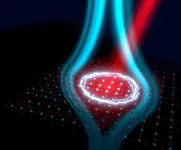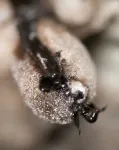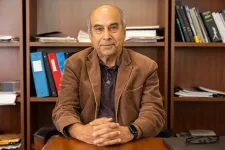Light-induced Meissner effect in optically driven YBa2Cu3O6.48
2024-07-12
(Press-News.org)
Superconductivity is a fascinating phenomenon, which allows a material to sustain an electrical current without any loss. This collective quantum behavior of matter only appears in certain conductors at temperatures far below ambient.
A number of modern studies have investigated this behavior in so-called non-equilibrium states, that is in situations in which the material is pushed away from thermal equilibrium. In these conditions, it appears that at least some of the features of superconductivity can be recreated even at ambient temperatures. Such non-equilibrium high temperature superconductivity, shown to exist under irradiation with a laser pulse, may be useful for applications different from the ones envisaged for the stationary version of superconductivity, as for example in high-speed devices controlled by laser pulses.
This phenomenon has been termed “light-induced superconductivity”, signaling an analogy with its equilibrium counterpart.
An important frontier in the past decade has been to characterize the properties of one such light-induced superconducting state and understand how far this phase reproduces the known properties of a conventional superconductor.
Besides being capable of transporting electrical currents without loss, superconductors are also known to expel magnetic fields from their interior. This phenomenon, known in equilibrium conditions as the Meissner effect, is a direct consequence of the mutual coherence of the charge carriers and of their tendency to march in lockstep. However, measuring the expulsion of magnetic fields for light-induced superconductivity has been challenging, because the effect only persists for a few picoseconds (one trillionth of a second), making it impossible to measure magnetic field changes with precision.
A team of researchers at the Max Planck Institute for the Structure and Dynamics of Matter (MPSD) in Hamburg, Germany, led by Andrea Cavalleri, has developed a new experiment capable of monitoring the magnetic properties of superconductors at very fast speeds. They have worked on laser-irradiated YBa2Cu3O6+x, a compound for which static superconductivity is only seen down to about −200 degrees Celsius. “We have discovered that photo-excited YBa2Cu3O6.48, in addition to featuring near zero resistance, also expels a static magnetic field from its interior,” says Sebastian Fava, author of the article now published in Nature.
This experiment was made possible by placing a spectator crystal in close vicinity of the sample under investigation and using it to measure the local magnetic field strength. The crystal reflects changes in the magnetic field into changes in the polarization state of a femtosecond laser pulse. “Due to the short duration of the probe pulse, we can reconstruct the time evolution of the magnetic field surrounding the YBa2Cu3O6.48sample with sub-picosecond resolution and unprecedented sensitivity,” says Giovanni de Vecchi, one of the co-authors.
“The photo-induced magnetic field expulsion we observed is comparable in size to the one measured when YBa2Cu3O6+x is made superconducting at equilibrium by cooling,” adds fellow author Michele Buzzi. “This suggests that driving the material may even be an effective route to bring its superconducting properties closer to ambient conditions,” continues co-author Gregor Jotzu, now a faculty member at EPFL and head of the Dynamic Quantum Materials Laboratory. As a consensus on the microscopic origin of light-induced superconductivity in YBa2Cu3O6.48 is still missing, these results are an important benchmark for current theories.
In YBa2Cu3O6+x, the superconducting order does not completely disappear above the equilibrium superconducting transition temperature and some local fluctuating superconducting order remains, somewhat similar to a disordered state. These groundbreaking discoveries suggest that photo-excitation of YBa2Cu3O6+xwith tailored light pulses can be used to synchronize this fluctuating state and restore the superconducting order at temperatures much higher than the ones at which the material becomes superconducting at equilibrium, all the way to room temperature.
The research at the MPSD received financial support from the Deutsche Forschungsgemeinschaft via the Cluster of Excellence CUI: Advanced Imaging of Matter. The MPSD is a member of the Center for Free-Electron Laser Science (CFEL), a joint enterprise with DESY and the University of Hamburg. The research was carried out in close collaboration with scientists at the Max Planck Institute for Solid State Research (MPI-FKF).
END
[Attachments] See images for this press release:

ELSE PRESS RELEASES FROM THIS DATE:
2024-07-12
New research to be presented at this year’s Annual Meeting of the European Association for the Study of Diabetes (EASD) (Madrid, 9-13 September) shows that people recently diagnosed with diabetes who experience short or long sleep duration are more likely to experience microvascular disease (damage to the small blood vessels), which could ultimately lead to more serious complications. The study is by Mette Johansen and Thomas Olesen, Steno Diabetes Center Odense, Odense University Hospital, Odense, Denmark, and colleagues.
Microvascular complications, such as retinopathy and nephropathy, are major contributors ...
2024-07-11
Whether it’s a pharmacy, a supermarket, or a clothier, when you walk into a retail store in the U.S., you are sure to encounter a flashy promotional display featuring products from a specific brand.
It’s a marketing strategy that’s been proved to be highly effective at boosting sales. Brands carefully plan display campaigns, signing contracts with retailers that specify when to install the exhibits and for how long. They often provide financial incentives to encourage compliance.
But a new study from Ashish ...
2024-07-11
An invasive fungus that colonizes the skin of hibernating bats with deadly consequences is a stealthy invader that uses multiple strategies to slip into the small mammals' skin cells and quietly manipulate them to aid its own survival. The fungus, which causes the disease white-nose syndrome, has devastated several North American species over the last 18 years.
Scientists have learned much about the fungus, Pseudogymnoascus destructans, since it was first documented in a New York cave in 2006, including where it thrives, its distribution, and clinical features. But exactly ...
2024-07-11
According to current understanding, menstrual cramps only happen in cycles in which an egg is released, or an ovulatory cycle. But new research from the University of British Columbia (UBC) is challenging this notion.
The findings, published in the Journal of Pain Research, reveal that some women not only experience cramps when no egg is released, but that cramps can be more severe and last longer during these anovulatory cycles.
“I was surprised to see significant cramps in menstrual cycles with or without ovulation, which challenges current thinking” said co-author, Dr. Paul Yong, associate professor of obstetrics and gynecology at UBC and Canada Research ...
2024-07-11
Racial disparities in dementia are due to social determinants of health, with genetic ancestry playing no role, according to a new study led by researchers at Washington University School of Medicine in St. Louis.
The study, which was based on a long-running population-based survey in four Latin American countries, helps explain why people of predominantly Native American or African ancestry have a higher prevalence of dementia: Study participants were more likely to experience social contexts and health conditions that raised their risk of cognitive decline, such as lower education levels, rural residency and high blood pressure. Once such factors ...
2024-07-11
HOUSTON – (July 11, 2024) – Implantable technologies have significantly improved our ability to study and even modulate the activity of neurons in the brain, but neurons in the spinal cord are harder to study in action.
“If we understood exactly how neurons in the spinal cord process sensation and control movement, we could develop better treatments for spinal cord disease and injury,” said Yu Wu, a research scientist who is part of a team of Rice University neuroengineers working on a solution to this problem.
“We developed a tiny sensor, spinalNET, that records the electrical activity of spinal neurons as the subject performs normal ...
2024-07-11
Image
The flow of water within a muscle fiber may dictate how quickly muscle can contract, according to a University of Michigan study.
Nearly all animals use muscle to move, and it's been known for a long time that muscle, like all other cells, is composed of about 70% water. But researchers don't know what sets the range and upper limits of muscle performance. Previous research into how muscle works focused only on how it worked on a molecular level rather than how muscle fibers are shaped, that they are three-dimensional ...
2024-07-11
Nearly one in 10 people who get COVID while pregnant will go on to develop long COVID, a report publishing July 11th in Obstetrics & Gynecology has found.
“It was surprising to me that the prevalence was that high,” says Torri Metz, MD, vice chair of research of obstetrics and gynecology at University of Utah Health, who co-led the nationwide study. “This is something that does continue to affect otherwise reasonably healthy and young populations.”
Intersecting risks
Prior research had shown that COVID affects pregnant people in uniquely ...
2024-07-11
UNIVERSITY PARK, Pa. — The rabbit hole contains madness, according to author Lewis Carroll. Online, that madness manifests in the form of increasingly extreme content, often without users realizing it. A new study by Penn State researchers suggests that giving users control over the interface feature of autoplay can help them realize that they are going down a rabbit hole.
The work — which the researchers said has implications for responsibly designing online content viewing platforms and algorithms, as well as helping users better ...
2024-07-11
VIDEO: https://www.youtube.com/watch?v=6j4zjqI21Gs
Faculty in UCF’s College of Sciences and College of Engineering and Computer Science are preparing incoming students to keep pace with the emerging multidisciplinary field of artificial intelligence.
A team of five faculty, led by UCF’s Center for Research in Computer Vision (CRCV), recently received a U.S. National Science Foundation grant totaling nearly $2.5 million over five years to serve as resources to uplift bright yet low-income or struggling ...
LAST 30 PRESS RELEASES:
[Press-News.org] Light-induced Meissner effect in optically driven YBa2Cu3O6.48






